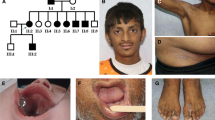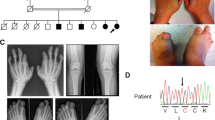Summary
X-linked dominant chondrodysplasia punctata is a human gene defect characterized by punctate foci of epiphyseal calcification, cataracts, ichthyosis, and systematized atrophoderma. In a comparative study, the murine X-linked mutant ‘bare patches’ was found to display strikingly similar skeletal, ocular, and cutancous anomalies. The human as well as the murine phenotypes occur exclusively in the female sex, apparently because the underlying mutations are lethal for male embryos. In both traits, the cutaneous lesions are arranged in a linear and blotchy pattern reflecting lyonization. The observed similarities constitute strong evidence that the two genes are homologous. The proposed homology is a further example of the evolutionary conservatism of the X-chromosome in mammals.
Similar content being viewed by others
References
Dalton TP, Edwards JH, Evans EP, Lyon MF, Parkinson SP, Peters J, Searle AG (1981) Chromosome maps of man and mouse. Clin Genet 20:407–415
Francke U, Taggart RT (1980) Comparative gene mapping: Order of loci on the X-chromosome is different in mice and humans. Proc Natl Acad Sci USA 77:3595–3599
Happle R (1977) Dermatologische Leitsymptome einer Sonderform der Chondrodysplasia punctata. Hautarzt 28, Suppl 2:260–263
Happle R (1979) X-linked dominant chondrodysplasia punctata. Review of literature and report of a case. Hum Genet 53:65–73
Happle R (1981) Cataracts as a marker of genetic heterogeneity in chondrodysplasia punctata. Clin Genet 19:64–66
Lenz W (1979) Medizinische Genetik (4th ed). Thieme Verlag, Stuttgart, pp 92–95
Lyon MF (1961) Gene action in the X-chromosome of the mouse (Mus musculus L.). Nature 190:372–373
McKusick VA (1980) The anatomy of the human genome. J Hered 71:370–391
Nachtsheim H (1956) Vergleichende und experimentelle Erbpathologie in ihren Beziehungen zur Humangenetik. Acta Genet (Basel) 6:223–239
Ohno S (1973) Sex chromosomes and sex-linked genes. Springer-Verlag, Berlin, pp 46–73
Ohno S (1967) Ancient linkage groups and frozen accidents. Nature 244:259–262
Phillips RJS, Hawker SH, Moseley HJ (1973) Bare-patches, a new sexlinked gene in the mouse, associated with a high production of XO females. I. A preliminary report of breeding experiments. Genet Res 22:91–99
Author information
Authors and Affiliations
Additional information
R. J. S. Phillips was deceased.
Rights and permissions
About this article
Cite this article
Happle, R., Phillips, R.J.S., Roessner, A. et al. Homologous genes for X-linked chondrodysplasia punctata in man and mouse. Hum Genet 63, 24–27 (1983). https://doi.org/10.1007/BF00285392
Received:
Published:
Issue Date:
DOI: https://doi.org/10.1007/BF00285392



